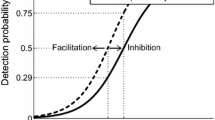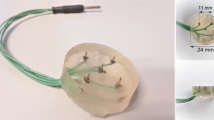Abstract
Electrical stimulation of cutaneous tissue through surface electrodes is an often used method for evoking experimental pain. However, at painful intensities both non-nociceptive Aβ-fibers and nociceptive Aδ- and C-fibers may be activated by the electrical stimulation. This study proposes a finite element (FE) model of the extracellular potential and stochastic branching fiber model of the afferent fiber excitation thresholds. The FE model described four horizontal layers; stratum corneum, epidermis, dermis, and hypodermal used to estimate the excitation threshold of Aβ-fibers terminating in dermis and Aδ-fibers terminating in epidermis. The perception thresholds of 11 electrodes with diameters ranging from 0.2 to 20 mm were modeled and assessed on the volar forearm of healthy human volunteers by an adaptive two-alternative forced choice algorithm. The model showed that the magnitude of the current density was highest for smaller electrodes and decreased through the skin. The excitation thresholds of the Aδ-fibers were lower than the excitation thresholds of Aβ-fibers when current was applied through small, but not large electrodes. The experimentally assessed perception threshold followed the lowest excitation threshold of the modeled fibers. The model confirms that preferential excitation of Aδ-fibers may be achieved by small electrode stimulation due to higher current density in the dermoepidermal junction.







Similar content being viewed by others
References
Biurrun Manresa JA, Mørch CD, Andersen OK (2010) Long-term facilitation of nociceptive withdrawal reflexes following low-frequency conditioning electrical stimulation: a new model for central sensitization in humans. Euro J Pain 14(8):822–831
Blair EA, Erlanger J (1933) A comparison of the characteristics of axons through their individual electrical responses. Am J Physiol 106(3):524–564
Bromm B, Meier W (1984) The intracutaneous stimulus—a new pain model for algesimetric studies. Methods Find Exp Clin Pharmacol 6(7):405–410
Drewes AM, Helweglarsen S, Petersen P, Brennum J, Andreasen A, Poulsen LH, Jensen TS (1993) Mcgill pain questionnaire translated into Danish—experimental and clinical findings. Clin J Pain 9(2):80–87
Ebenezer GJ, Hauer P, Gibbons C, McArthur JC, Polydefkis M (2007) Assessment of epidermal nerve fibers: a new diagnostic and predictive tool for peripheral neuropathies. J Neuropathol Exp Neurol 66(12):1059–1073
Fornage BD, McGavran MH, Duvic M, Waldron CA (1993) Imaging of the skin with 20-MHz US. Radiology 189(1):69–76
Gabriel S, Lau RW, Gabriel C (1996) The dielectric properties of biological tissues: II. Measurements in the frequency range 10 Hz to 20 GHz. Phys Med Biol 41(11):2251–2269
Gabriel C, Gabriel S, Corthout E (1996) The dielectric properties of biological tissues: I. Literature survey. Phys Med Biol 41(11):2231–2249
Gabriel C, Peyman A, Grant EH (2009) Electrical conductivity of tissue at frequencies below 1 MHz. Phys Med Biol 54(16):4863–4878
Gardner EP, Martin JH, Jessell TM (2000) The Bodily Senses. In: Kandel ER, Schwartz JH, Jessell TM (eds) Principles of Neural Science, 4th edn. McGraw-Hill, New York, pp 430–450
GA Gescheider (1997) Psychophysics.In: The Fundamentals.Lawrence Erlbaum Associates, Mahwah
Hilliges M, Wang LX, Johansson O (1995) Ultrastructural evidence for nerve-fibers within all vital layers of the human epidermis. J Invest Dermatol 104(1):134–137
Iggo A, Andres KH (1982) Morphology of cutaneous receptors. Annu Rev Neurosci 5:1–31
Inui K, Tran TD, Hoshiyama M, Kakigi R (2002) Preferential stimulation of A-delta fibers by intra-epidermal needle electrode in humans. Pain 96(3):247–252
Ji RR, Kohno T, Moore KA, Woolf CJ (2003) Central sensitization and LTP: do pain and memory share similar mechanisms? Trends Neurosci 26(12):696–705
Johansson RS, Vallbo AB (1979) Detection of tactile stimuli—thresholds of afferent units related to psychophysical thresholds in the human hand. J Physiol 297:405–422
Kaube H, Katsarava Z, Kaufer T, Diener HC, Ellrich J (2000) A new method to increase nociception specificity of the human blink reflex. Clin Neurophysiol 111(3):413–416
Klein T, Magerl W, Hopf HC, Sandkuhler J, Treede RD (2004) Perceptual correlates of nociceptive long-term potentiation and long-term depression in humans. J Neurosci 24(4):964–971
Krackowizer P, Brenner E (2008) Thickness of the human skin: 24 points of measurement. Phlebologie 37(2):83–92
Kuhn A, Keller T, Lawrence M, Morari M (2009) A model for transcutaneous current stimulation: simulations and experiments. Med Biol Eng Comput 47(3):279–289
Kuhn A, Keller T, Micera S, Morari M (2009) Array electrode design for transcutaneous electrical stimulation: a simulation study. Med Eng Phys 31(8):945–951
Lauria G, Cornblath DR, Johansson O, McArthur JC, Mellgren SI, Nolano M, Rosenberg N, Sommer C (2005) EFNS guidelines on the use of skin biopsy in the diagnosis of peripheral neuropathy. Eur J Neurol 12(10):747–758
McIntyre CC, Richardson AG, Grill WM (2002) Modeling the excitability of mammalian nerve fibers: influence of afterpotentials on the recovery cycle. J Neurophysiol 87(2):995–1006
Mcneal DR (1976) Analysis of a model for excitation of myelinated nerve. IEEE Trans Biomed Eng 23(4):329–337
Melzack R (1975) The McGill pain questionnaire: major properties and scoring methods. Pain 1(3):277–299
Neerken S, Lucassen GW, Bisschop MA, Lenderink E, Nuijs TAM (2004) Characterization of age-related effects in human skin: a comparative study that applies confocal laser scanning microscopy and optical coherence tomography. J Biomed Opt 9(2):274–281
Nilsson HJ, Levinsson A, Schouenborg J (1997) Cutaneous field stimulation (CFS): a new powerful method to combat itch. Pain 71(1):49–55
Nolano M, Provitera V, Crisci C, Stancanelli A, Wendelschafer-Crabb G, Kennedy WR, Santoro L (2003) Quantification of myelinated endings and mechanoreceptors in human digital skin. Ann Neurol 54(2):197–205
Ochoa J, Torebjork E (1989) “Sensations evoked by intraneural microstimulation of C nociceptor fibers in human-skin nerves”. J Physiol 415:583–599
Peng YB, Ringkamp M, Campbell JN, Meyer RA (1999) Electrophysiological assessment of the cutaneous arborization of A delta-fiber nociceptors. J Neurophysiol 82(3):1164–1177
Provitera V, Nolano M, Pagano A, Caporaso G, Stancanelli A, Santoro L (2007) Myelinated nerve endings in human skin. Muscle Nerve 35(6):767–775
Rattay F (1986) Analysis of models for external stimulation of axons. IEEE Trans Biomed Eng 33(10):974–977
Rattay F (1989) Analysis of models for extracellular fiber stimulation. IEEE Trans Biomed Eng 36(7):676–682
Reilly DM, Ferdinando D, Johnston C, Shaw C, Buchanan KD, Green MR (1997) The epidermal nerve fibre network: characterization of nerve fibres in human skin by confocal microscopy and assessment of racial variations. Br J Dermatol 137(2):163–170
Rottmann S, Jung K, Ellrich J (2009) Electrical low-frequency stimulation induces long-term depression of sensory and affective components of pain in healthy man. Euro J Pain 14(4):359–365
Sandby-Moller J, Poulsen T, Wulf HC (2003) Epidermal thickness at different body sites: relationship to age, gender, pigmentation, blood content, skin type and smoking habits. Acta Derm Venereol 83(6):410–413
Sandkuhler J, Liu XG (1998) Induction of long-term potentiation at spinal synapses by noxious stimulation or nerve injury. Eur J Neurosci 10(7):2476–2480
Sha N, Kenney LPJ, Heller BW, Barker AT, Howard D, Moatamedi M (2008) A finite element model to identify electrode influence on current distribution in the skin. Artif Organs 32(8):639–643
Tavernier A, Dierickx M, Hinsenkamp M (1993) Tensors of dielectric permittivity and conductivity of in vitro human dermis and epidermis. Bioelectrochem Bioenerg 30:65–72
Wall PD (1978) Gate control-theory of pain mechanisms—re-examination and re-statement. Brain 101:1–18
Weaver JC (1993) Electroporation—a general phenomenon for manipulating cells and tissues. J Cell Biochem 51(4):426–435
Weidner C, Schmidt R, Schmelz M, Torebjork HE, Handwerker HO (2003) Action potential conduction in the terminal arborisation of nociceptive C-fibre afferents. J Physiol 547(3):931–940
Woock J, Yoo P, Grill W (2010) Finite element modeling and in vivo analysis of electrode configurations for selective stimulation of pudendal afferent fibers. BMC Urol 10(1):11
Yamamoto T, Yamamoto Y (1976) Electrical-properties of epidermal stratum-corneum. Med Biol Eng 14(2):151–158
Yamamoto T, Yamamoto Y (1981) Non-linear electrical-properties of skin in the low-frequency range. Med Biol Eng Comput 19(3):302–310
Yoshida K, Inmann A, Haugland MK (1999) Measurement of complex impedance spectra of implanted electrodes. In: IFESS 1999 proceedings of the 4th annual conference of the international functional electrical stimulation society,Sendai, 267–269 Aug 1999
Acknowledgment
The project was financed by The Danish Council for Independent Research | Technology and Production Sciences.
Author information
Authors and Affiliations
Corresponding author
Rights and permissions
About this article
Cite this article
Mørch, C.D., Hennings, K. & Andersen, O.K. Estimating nerve excitation thresholds to cutaneous electrical stimulation by finite element modeling combined with a stochastic branching nerve fiber model. Med Biol Eng Comput 49, 385–395 (2011). https://doi.org/10.1007/s11517-010-0725-8
Received:
Accepted:
Published:
Issue Date:
DOI: https://doi.org/10.1007/s11517-010-0725-8




